Scope Management Plan for Bungalow Project
VerifiedAdded on 2023/01/17
|13
|1841
|77
AI Summary
This document provides a detailed scope management plan for the Bungalow Project, including scope definition, work breakdown structure, scope validation, and scope control.
Contribute Materials
Your contribution can guide someone’s learning journey. Share your
documents today.

Running Head: PROJECT MANAGEMENT
Bungalow Project
Name of the Student
Name of the University
Bungalow Project
Name of the Student
Name of the University
Secure Best Marks with AI Grader
Need help grading? Try our AI Grader for instant feedback on your assignments.
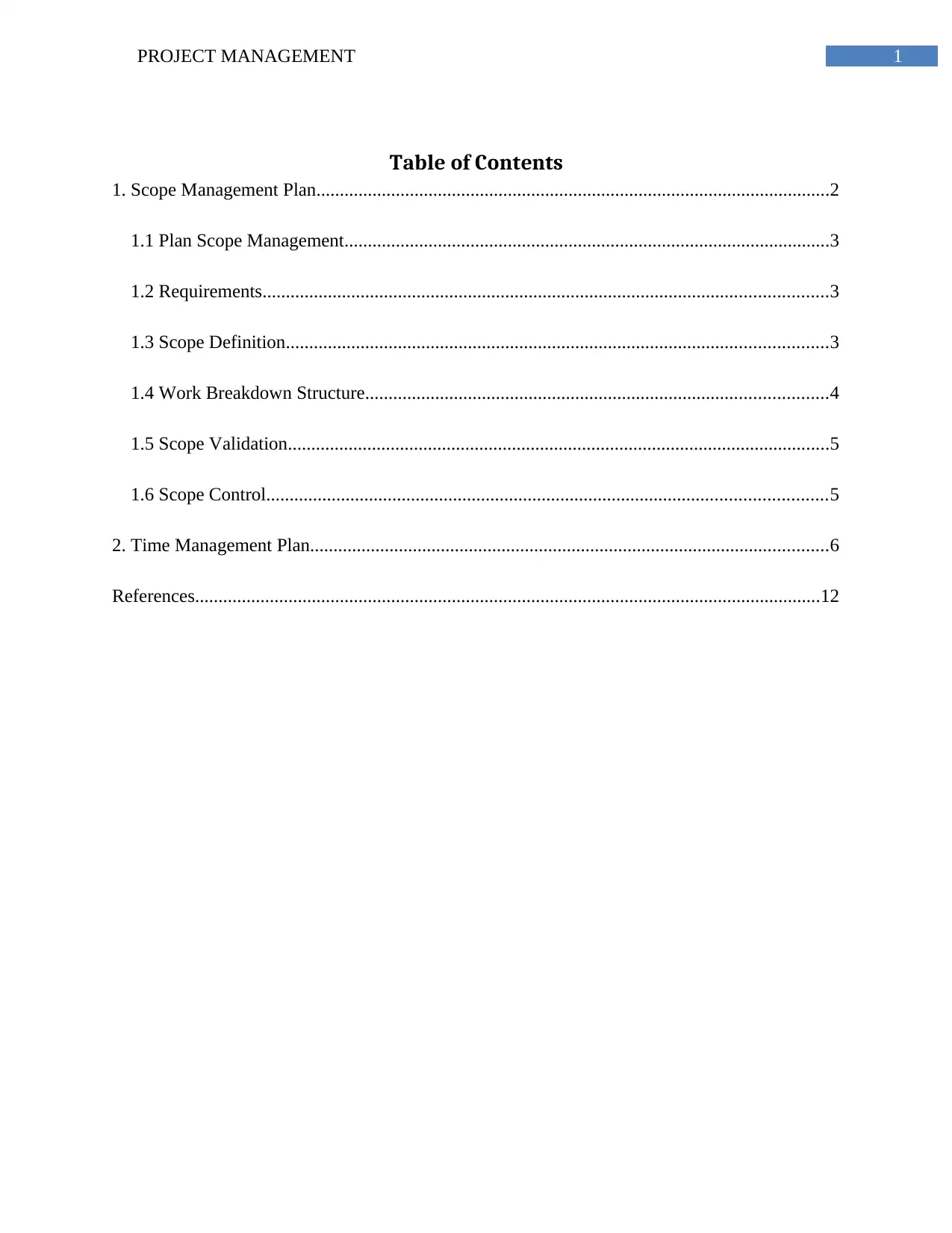
1PROJECT MANAGEMENT
Table of Contents
1. Scope Management Plan..............................................................................................................2
1.1 Plan Scope Management........................................................................................................3
1.2 Requirements.........................................................................................................................3
1.3 Scope Definition....................................................................................................................3
1.4 Work Breakdown Structure...................................................................................................4
1.5 Scope Validation....................................................................................................................5
1.6 Scope Control........................................................................................................................5
2. Time Management Plan...............................................................................................................6
References......................................................................................................................................12
Table of Contents
1. Scope Management Plan..............................................................................................................2
1.1 Plan Scope Management........................................................................................................3
1.2 Requirements.........................................................................................................................3
1.3 Scope Definition....................................................................................................................3
1.4 Work Breakdown Structure...................................................................................................4
1.5 Scope Validation....................................................................................................................5
1.6 Scope Control........................................................................................................................5
2. Time Management Plan...............................................................................................................6
References......................................................................................................................................12
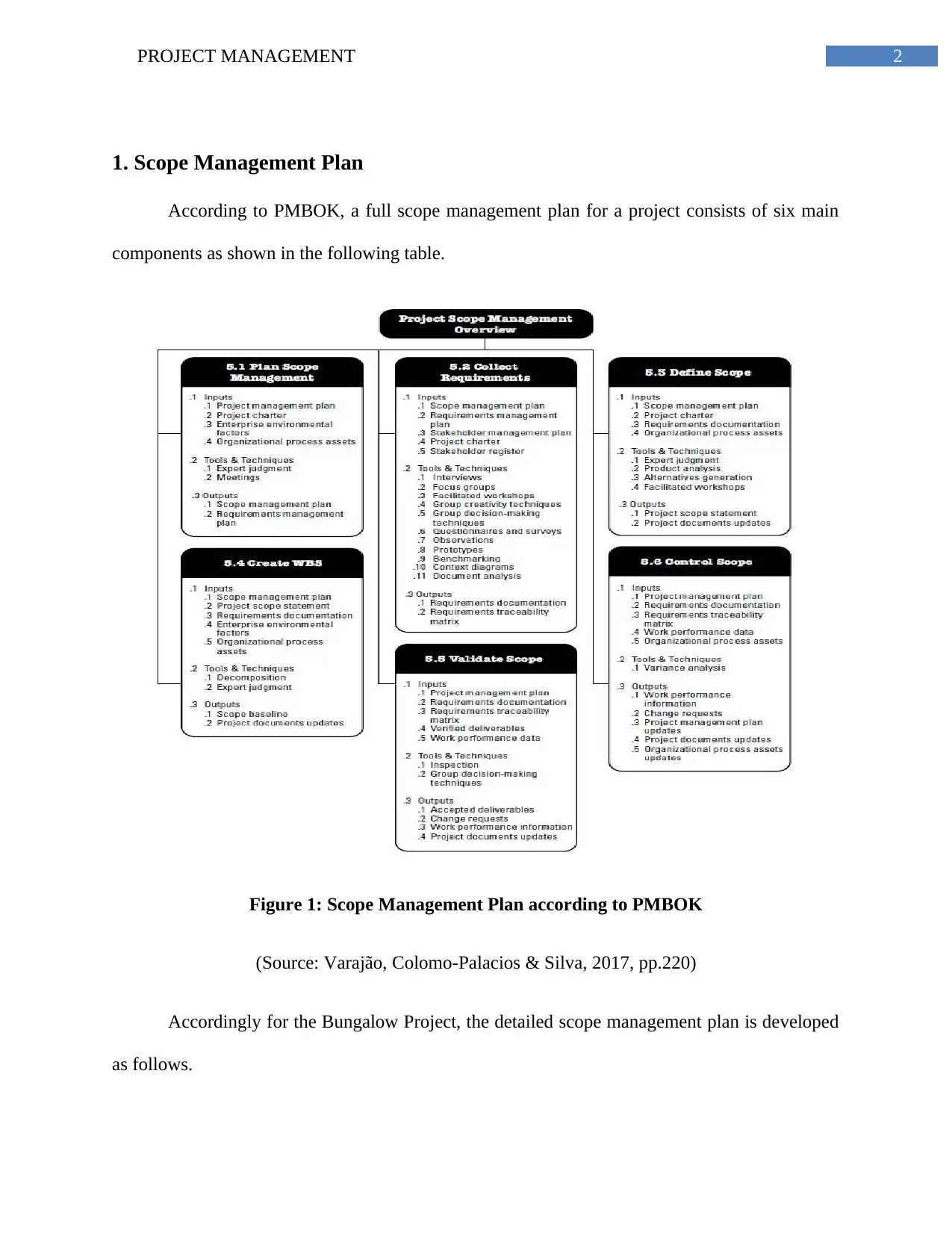
2PROJECT MANAGEMENT
1. Scope Management Plan
According to PMBOK, a full scope management plan for a project consists of six main
components as shown in the following table.
Figure 1: Scope Management Plan according to PMBOK
(Source: Varajão, Colomo-Palacios & Silva, 2017, pp.220)
Accordingly for the Bungalow Project, the detailed scope management plan is developed
as follows.
1. Scope Management Plan
According to PMBOK, a full scope management plan for a project consists of six main
components as shown in the following table.
Figure 1: Scope Management Plan according to PMBOK
(Source: Varajão, Colomo-Palacios & Silva, 2017, pp.220)
Accordingly for the Bungalow Project, the detailed scope management plan is developed
as follows.
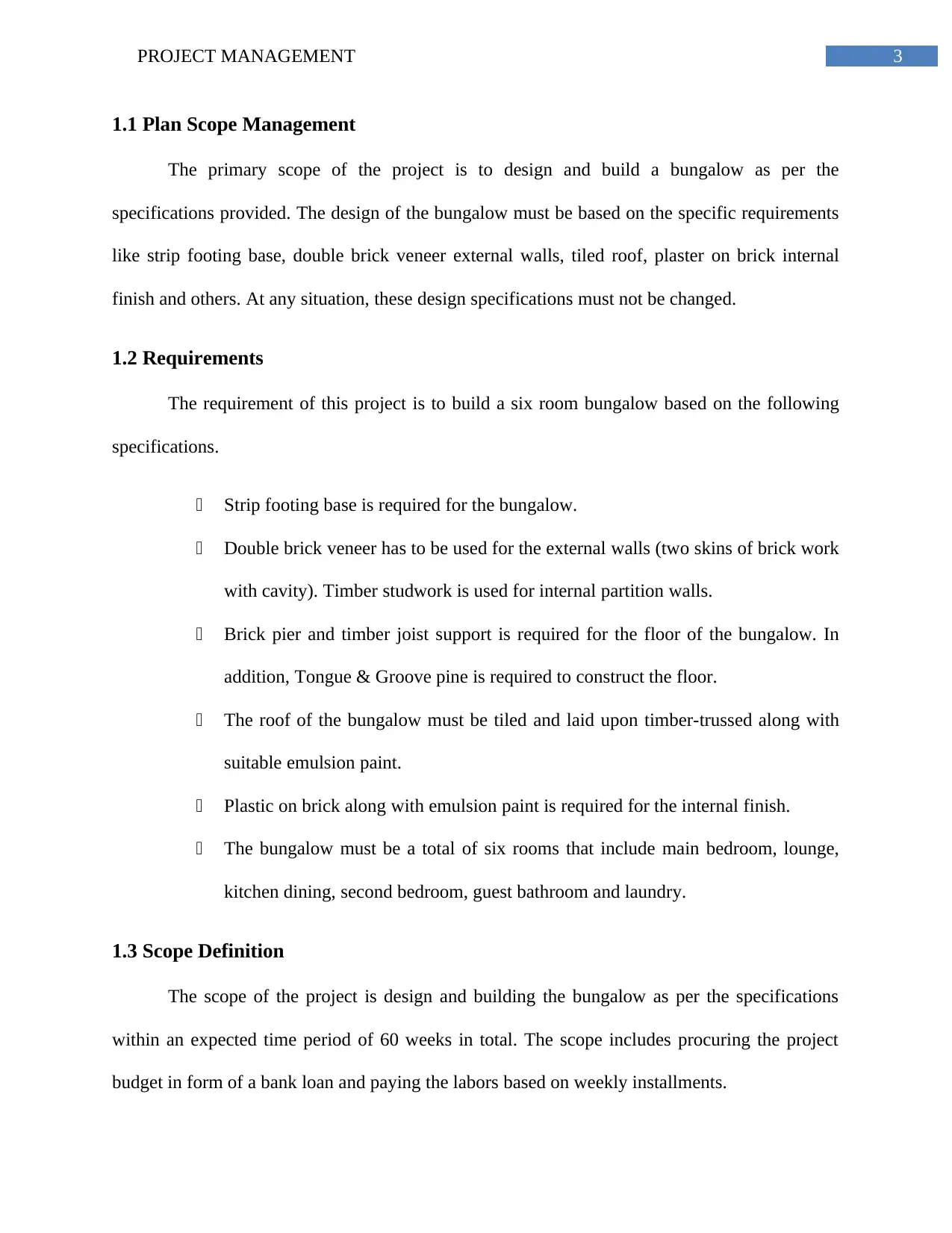
3PROJECT MANAGEMENT
1.1 Plan Scope Management
The primary scope of the project is to design and build a bungalow as per the
specifications provided. The design of the bungalow must be based on the specific requirements
like strip footing base, double brick veneer external walls, tiled roof, plaster on brick internal
finish and others. At any situation, these design specifications must not be changed.
1.2 Requirements
The requirement of this project is to build a six room bungalow based on the following
specifications.
Strip footing base is required for the bungalow.
Double brick veneer has to be used for the external walls (two skins of brick work
with cavity). Timber studwork is used for internal partition walls.
Brick pier and timber joist support is required for the floor of the bungalow. In
addition, Tongue & Groove pine is required to construct the floor.
The roof of the bungalow must be tiled and laid upon timber-trussed along with
suitable emulsion paint.
Plastic on brick along with emulsion paint is required for the internal finish.
The bungalow must be a total of six rooms that include main bedroom, lounge,
kitchen dining, second bedroom, guest bathroom and laundry.
1.3 Scope Definition
The scope of the project is design and building the bungalow as per the specifications
within an expected time period of 60 weeks in total. The scope includes procuring the project
budget in form of a bank loan and paying the labors based on weekly installments.
1.1 Plan Scope Management
The primary scope of the project is to design and build a bungalow as per the
specifications provided. The design of the bungalow must be based on the specific requirements
like strip footing base, double brick veneer external walls, tiled roof, plaster on brick internal
finish and others. At any situation, these design specifications must not be changed.
1.2 Requirements
The requirement of this project is to build a six room bungalow based on the following
specifications.
Strip footing base is required for the bungalow.
Double brick veneer has to be used for the external walls (two skins of brick work
with cavity). Timber studwork is used for internal partition walls.
Brick pier and timber joist support is required for the floor of the bungalow. In
addition, Tongue & Groove pine is required to construct the floor.
The roof of the bungalow must be tiled and laid upon timber-trussed along with
suitable emulsion paint.
Plastic on brick along with emulsion paint is required for the internal finish.
The bungalow must be a total of six rooms that include main bedroom, lounge,
kitchen dining, second bedroom, guest bathroom and laundry.
1.3 Scope Definition
The scope of the project is design and building the bungalow as per the specifications
within an expected time period of 60 weeks in total. The scope includes procuring the project
budget in form of a bank loan and paying the labors based on weekly installments.
Secure Best Marks with AI Grader
Need help grading? Try our AI Grader for instant feedback on your assignments.
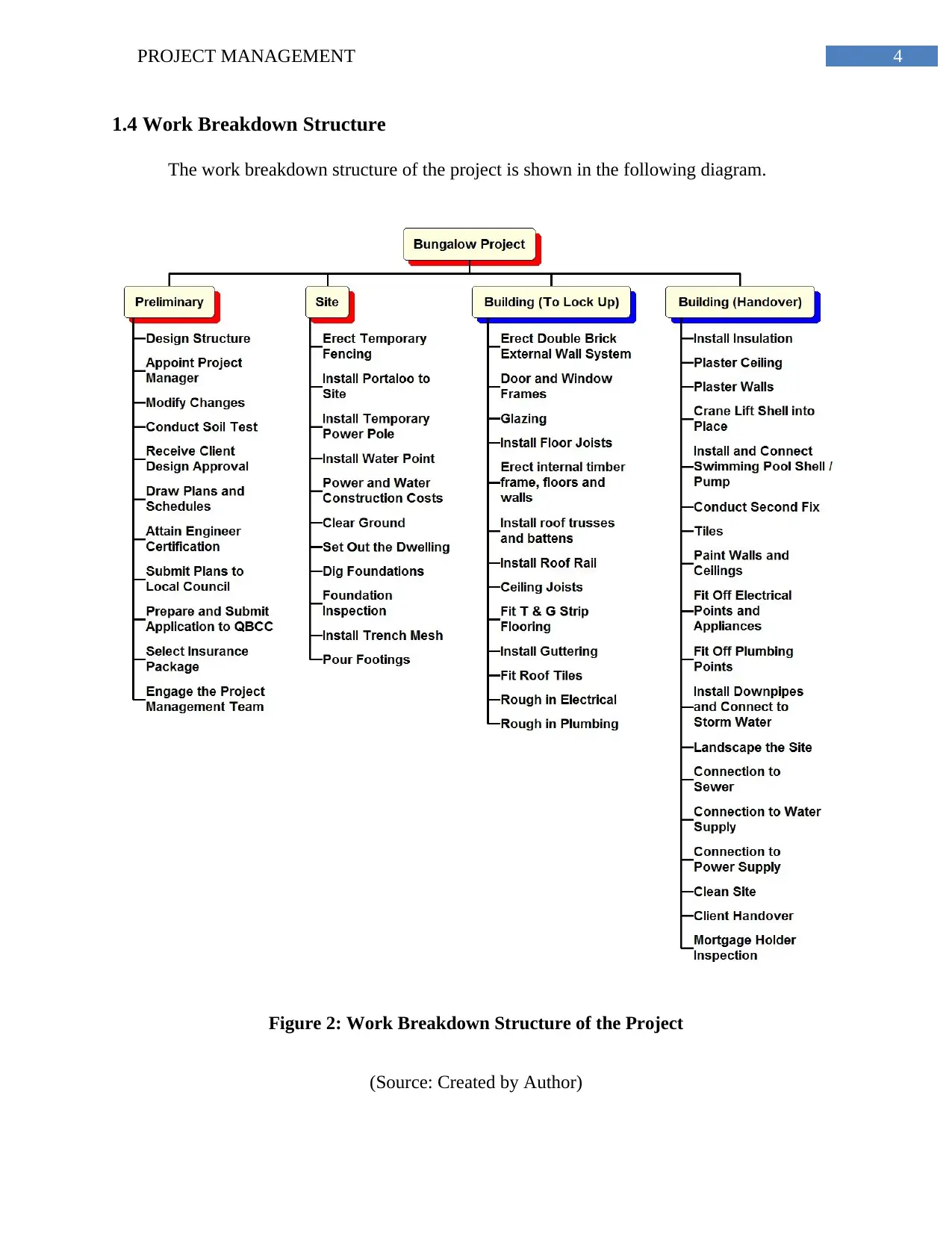
4PROJECT MANAGEMENT
1.4 Work Breakdown Structure
The work breakdown structure of the project is shown in the following diagram.
Figure 2: Work Breakdown Structure of the Project
(Source: Created by Author)
1.4 Work Breakdown Structure
The work breakdown structure of the project is shown in the following diagram.
Figure 2: Work Breakdown Structure of the Project
(Source: Created by Author)
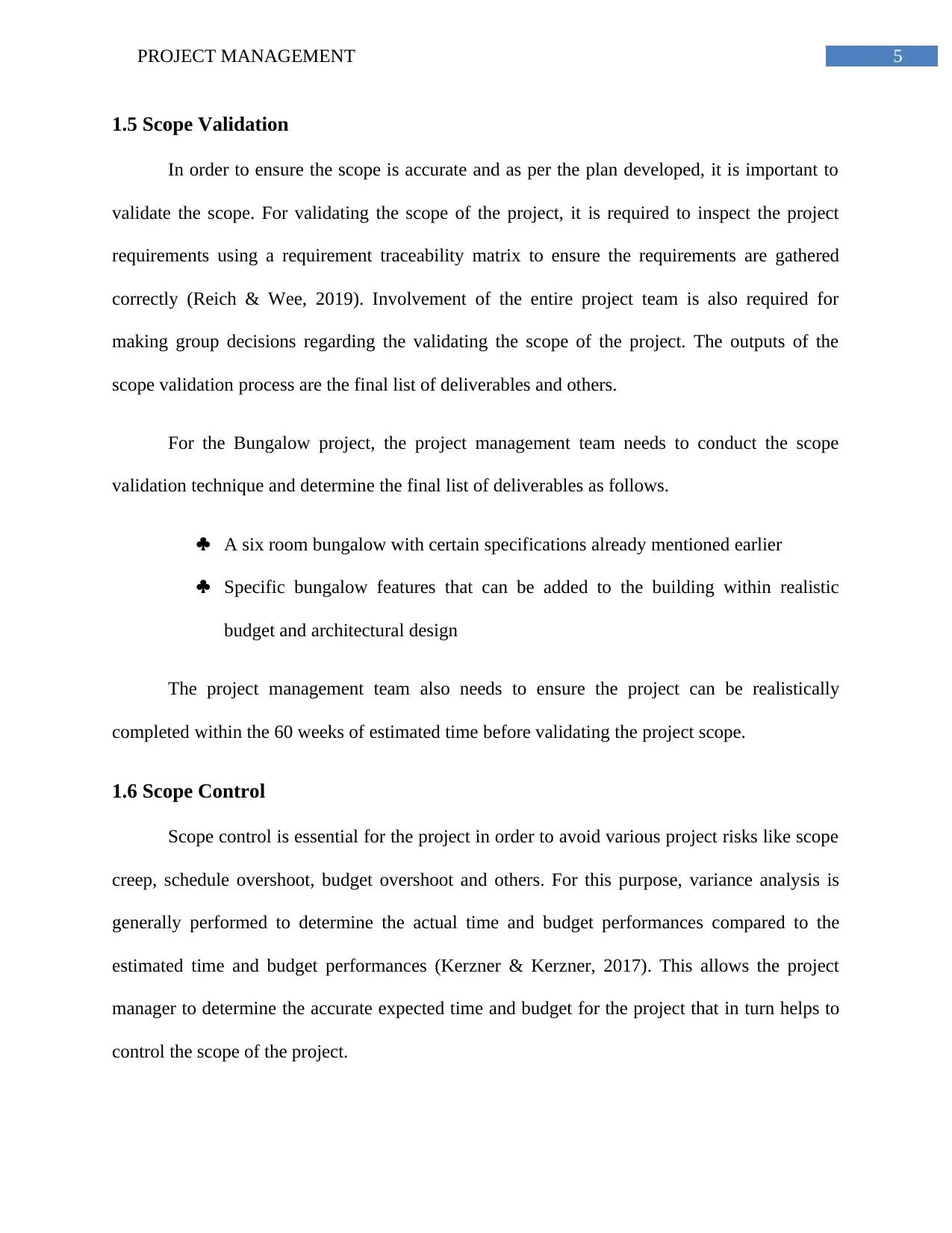
5PROJECT MANAGEMENT
1.5 Scope Validation
In order to ensure the scope is accurate and as per the plan developed, it is important to
validate the scope. For validating the scope of the project, it is required to inspect the project
requirements using a requirement traceability matrix to ensure the requirements are gathered
correctly (Reich & Wee, 2019). Involvement of the entire project team is also required for
making group decisions regarding the validating the scope of the project. The outputs of the
scope validation process are the final list of deliverables and others.
For the Bungalow project, the project management team needs to conduct the scope
validation technique and determine the final list of deliverables as follows.
A six room bungalow with certain specifications already mentioned earlier
Specific bungalow features that can be added to the building within realistic
budget and architectural design
The project management team also needs to ensure the project can be realistically
completed within the 60 weeks of estimated time before validating the project scope.
1.6 Scope Control
Scope control is essential for the project in order to avoid various project risks like scope
creep, schedule overshoot, budget overshoot and others. For this purpose, variance analysis is
generally performed to determine the actual time and budget performances compared to the
estimated time and budget performances (Kerzner & Kerzner, 2017). This allows the project
manager to determine the accurate expected time and budget for the project that in turn helps to
control the scope of the project.
1.5 Scope Validation
In order to ensure the scope is accurate and as per the plan developed, it is important to
validate the scope. For validating the scope of the project, it is required to inspect the project
requirements using a requirement traceability matrix to ensure the requirements are gathered
correctly (Reich & Wee, 2019). Involvement of the entire project team is also required for
making group decisions regarding the validating the scope of the project. The outputs of the
scope validation process are the final list of deliverables and others.
For the Bungalow project, the project management team needs to conduct the scope
validation technique and determine the final list of deliverables as follows.
A six room bungalow with certain specifications already mentioned earlier
Specific bungalow features that can be added to the building within realistic
budget and architectural design
The project management team also needs to ensure the project can be realistically
completed within the 60 weeks of estimated time before validating the project scope.
1.6 Scope Control
Scope control is essential for the project in order to avoid various project risks like scope
creep, schedule overshoot, budget overshoot and others. For this purpose, variance analysis is
generally performed to determine the actual time and budget performances compared to the
estimated time and budget performances (Kerzner & Kerzner, 2017). This allows the project
manager to determine the accurate expected time and budget for the project that in turn helps to
control the scope of the project.

6PROJECT MANAGEMENT
2. Time Management Plan
Based on the given durations for the project activities in the case study, the following
schedule has been developed.
WBS Duration Start Finish Predecessors
0 60 wks Mon 6/3/19 Fri 7/24/20
1 51 wks Mon 6/3/19 Fri 5/22/20
1.1 2 wks Mon 6/3/19 Fri 6/14/19
1.2 48 wks Mon 6/17/19 Fri 5/15/20 1.1
1.3 1 wk Mon 6/17/19 Fri 6/21/19 1.1
1.4 2 wks Mon 6/17/19 Fri 6/28/19 1.1
1.5 1 wk Mon 5/18/20 Fri 5/22/20 1.2
1.6 2 wks Mon 6/24/19 Fri 7/5/19 1.3
1.7 2 wks Mon 7/1/19 Fri 7/12/19 1.4
1.8 6 wks Mon 7/8/19 Fri 8/16/19 1.6
1.9 1 wk Mon 7/15/19 Fri 7/19/19 1.7
1.10 2 wks Mon 8/26/19 Fri 9/6/19 2.1
1.11 38 wks Mon 7/8/19 Fri 3/27/20 1.6
2. Time Management Plan
Based on the given durations for the project activities in the case study, the following
schedule has been developed.
WBS Duration Start Finish Predecessors
0 60 wks Mon 6/3/19 Fri 7/24/20
1 51 wks Mon 6/3/19 Fri 5/22/20
1.1 2 wks Mon 6/3/19 Fri 6/14/19
1.2 48 wks Mon 6/17/19 Fri 5/15/20 1.1
1.3 1 wk Mon 6/17/19 Fri 6/21/19 1.1
1.4 2 wks Mon 6/17/19 Fri 6/28/19 1.1
1.5 1 wk Mon 5/18/20 Fri 5/22/20 1.2
1.6 2 wks Mon 6/24/19 Fri 7/5/19 1.3
1.7 2 wks Mon 7/1/19 Fri 7/12/19 1.4
1.8 6 wks Mon 7/8/19 Fri 8/16/19 1.6
1.9 1 wk Mon 7/15/19 Fri 7/19/19 1.7
1.10 2 wks Mon 8/26/19 Fri 9/6/19 2.1
1.11 38 wks Mon 7/8/19 Fri 3/27/20 1.6
Paraphrase This Document
Need a fresh take? Get an instant paraphrase of this document with our AI Paraphraser
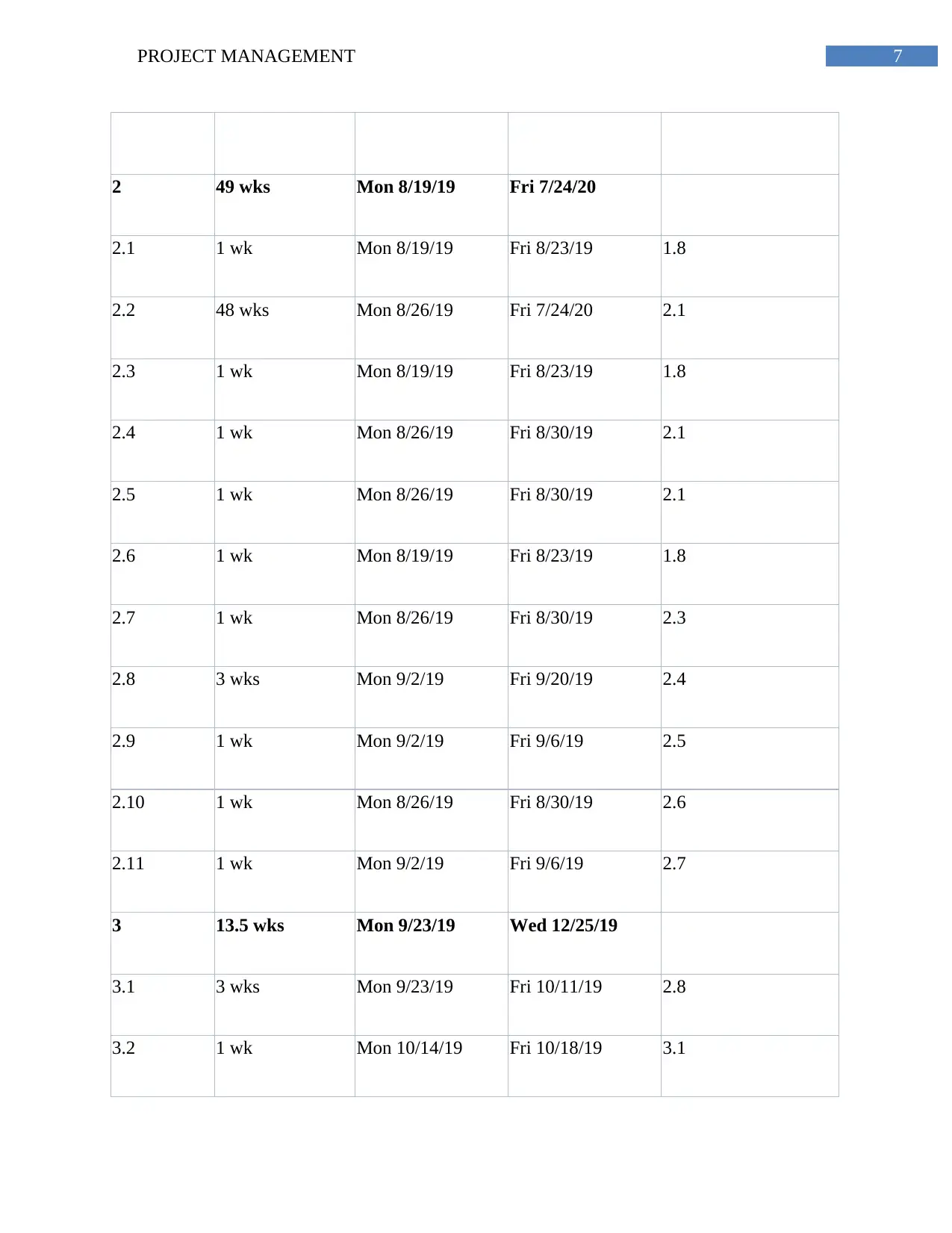
7PROJECT MANAGEMENT
2 49 wks Mon 8/19/19 Fri 7/24/20
2.1 1 wk Mon 8/19/19 Fri 8/23/19 1.8
2.2 48 wks Mon 8/26/19 Fri 7/24/20 2.1
2.3 1 wk Mon 8/19/19 Fri 8/23/19 1.8
2.4 1 wk Mon 8/26/19 Fri 8/30/19 2.1
2.5 1 wk Mon 8/26/19 Fri 8/30/19 2.1
2.6 1 wk Mon 8/19/19 Fri 8/23/19 1.8
2.7 1 wk Mon 8/26/19 Fri 8/30/19 2.3
2.8 3 wks Mon 9/2/19 Fri 9/20/19 2.4
2.9 1 wk Mon 9/2/19 Fri 9/6/19 2.5
2.10 1 wk Mon 8/26/19 Fri 8/30/19 2.6
2.11 1 wk Mon 9/2/19 Fri 9/6/19 2.7
3 13.5 wks Mon 9/23/19 Wed 12/25/19
3.1 3 wks Mon 9/23/19 Fri 10/11/19 2.8
3.2 1 wk Mon 10/14/19 Fri 10/18/19 3.1
2 49 wks Mon 8/19/19 Fri 7/24/20
2.1 1 wk Mon 8/19/19 Fri 8/23/19 1.8
2.2 48 wks Mon 8/26/19 Fri 7/24/20 2.1
2.3 1 wk Mon 8/19/19 Fri 8/23/19 1.8
2.4 1 wk Mon 8/26/19 Fri 8/30/19 2.1
2.5 1 wk Mon 8/26/19 Fri 8/30/19 2.1
2.6 1 wk Mon 8/19/19 Fri 8/23/19 1.8
2.7 1 wk Mon 8/26/19 Fri 8/30/19 2.3
2.8 3 wks Mon 9/2/19 Fri 9/20/19 2.4
2.9 1 wk Mon 9/2/19 Fri 9/6/19 2.5
2.10 1 wk Mon 8/26/19 Fri 8/30/19 2.6
2.11 1 wk Mon 9/2/19 Fri 9/6/19 2.7
3 13.5 wks Mon 9/23/19 Wed 12/25/19
3.1 3 wks Mon 9/23/19 Fri 10/11/19 2.8
3.2 1 wk Mon 10/14/19 Fri 10/18/19 3.1
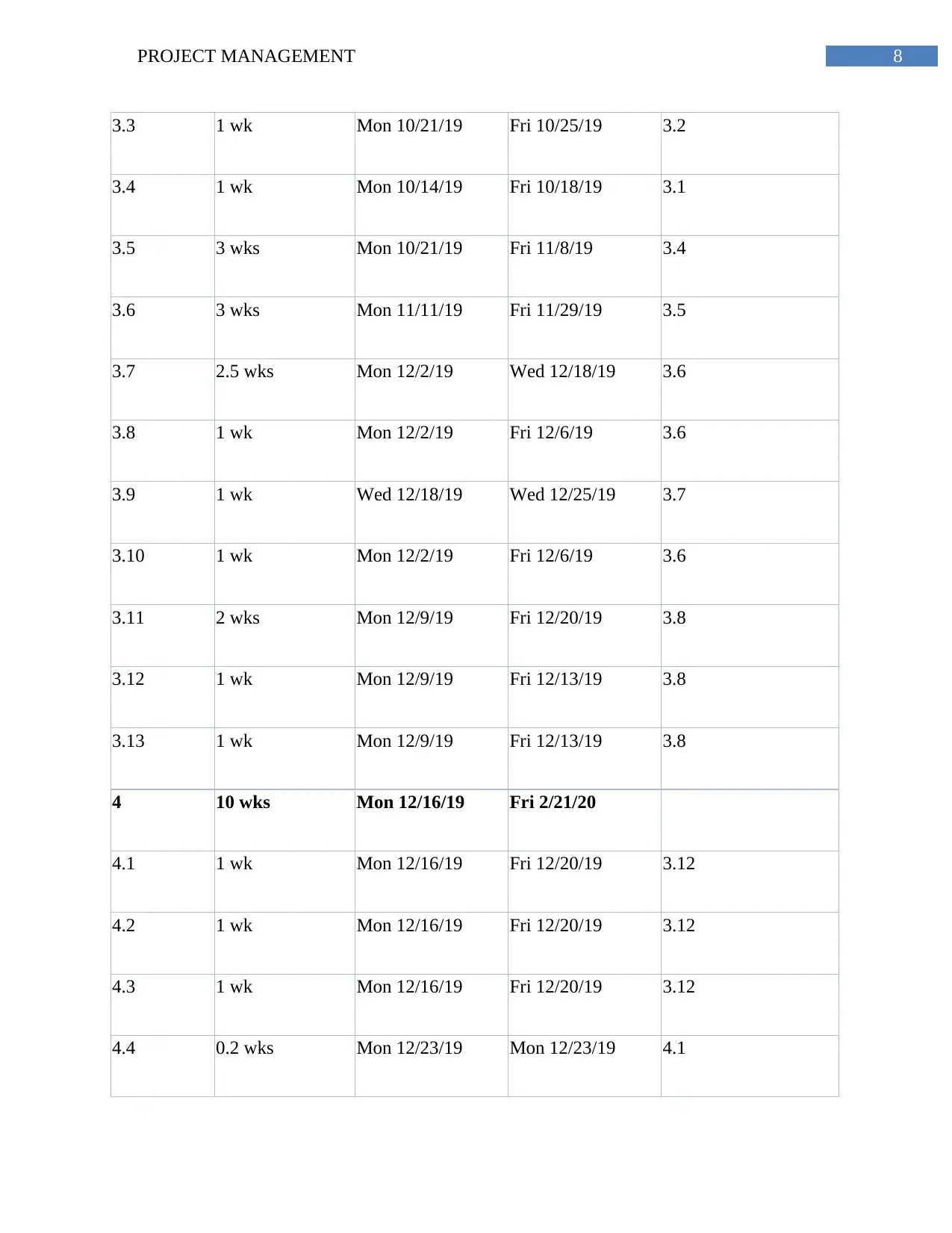
8PROJECT MANAGEMENT
3.3 1 wk Mon 10/21/19 Fri 10/25/19 3.2
3.4 1 wk Mon 10/14/19 Fri 10/18/19 3.1
3.5 3 wks Mon 10/21/19 Fri 11/8/19 3.4
3.6 3 wks Mon 11/11/19 Fri 11/29/19 3.5
3.7 2.5 wks Mon 12/2/19 Wed 12/18/19 3.6
3.8 1 wk Mon 12/2/19 Fri 12/6/19 3.6
3.9 1 wk Wed 12/18/19 Wed 12/25/19 3.7
3.10 1 wk Mon 12/2/19 Fri 12/6/19 3.6
3.11 2 wks Mon 12/9/19 Fri 12/20/19 3.8
3.12 1 wk Mon 12/9/19 Fri 12/13/19 3.8
3.13 1 wk Mon 12/9/19 Fri 12/13/19 3.8
4 10 wks Mon 12/16/19 Fri 2/21/20
4.1 1 wk Mon 12/16/19 Fri 12/20/19 3.12
4.2 1 wk Mon 12/16/19 Fri 12/20/19 3.12
4.3 1 wk Mon 12/16/19 Fri 12/20/19 3.12
4.4 0.2 wks Mon 12/23/19 Mon 12/23/19 4.1
3.3 1 wk Mon 10/21/19 Fri 10/25/19 3.2
3.4 1 wk Mon 10/14/19 Fri 10/18/19 3.1
3.5 3 wks Mon 10/21/19 Fri 11/8/19 3.4
3.6 3 wks Mon 11/11/19 Fri 11/29/19 3.5
3.7 2.5 wks Mon 12/2/19 Wed 12/18/19 3.6
3.8 1 wk Mon 12/2/19 Fri 12/6/19 3.6
3.9 1 wk Wed 12/18/19 Wed 12/25/19 3.7
3.10 1 wk Mon 12/2/19 Fri 12/6/19 3.6
3.11 2 wks Mon 12/9/19 Fri 12/20/19 3.8
3.12 1 wk Mon 12/9/19 Fri 12/13/19 3.8
3.13 1 wk Mon 12/9/19 Fri 12/13/19 3.8
4 10 wks Mon 12/16/19 Fri 2/21/20
4.1 1 wk Mon 12/16/19 Fri 12/20/19 3.12
4.2 1 wk Mon 12/16/19 Fri 12/20/19 3.12
4.3 1 wk Mon 12/16/19 Fri 12/20/19 3.12
4.4 0.2 wks Mon 12/23/19 Mon 12/23/19 4.1

9PROJECT MANAGEMENT
4.5 3 wks Mon 12/23/19 Fri 1/10/20 4.3
4.6 2 wks Mon 12/23/19 Fri 1/3/20 4.3
4.7 4 wks Mon 1/13/20 Fri 2/7/20 4.5
4.8 2 wks Mon 1/6/20 Fri 1/17/20 4.6
4.9 2 wks Mon 2/10/20 Fri 2/21/20 4.7
4.10 2 wks Mon 1/6/20 Fri 1/17/20 4.6
4.11 2 wks Wed 12/25/19 Wed 1/8/20 3.9
4.12 3 wks Mon 12/23/19 Fri 1/10/20 4.1
4.13 1 wk Mon 12/23/19 Fri 12/27/19 4.1
4.14 1 wk Mon 12/23/19 Fri 12/27/19 4.1
4.15 1 wk Mon 1/20/20 Fri 1/24/20 4.8
4.16 1 wk Wed 1/8/20 Wed 1/15/20 4.11
4.17 1 wk Mon 1/13/20 Fri 1/17/20 4.12
4.18 1 wk Mon 12/30/19 Fri 1/3/20 4.13
However, it is to be noted that these are only the likely durations of the project and do not
reflect the minimum expected duration. The minimum expected duration is determined using
three point estimation technique with the formula TE = (O + 4L + P)/6 where TE is the minimum
4.5 3 wks Mon 12/23/19 Fri 1/10/20 4.3
4.6 2 wks Mon 12/23/19 Fri 1/3/20 4.3
4.7 4 wks Mon 1/13/20 Fri 2/7/20 4.5
4.8 2 wks Mon 1/6/20 Fri 1/17/20 4.6
4.9 2 wks Mon 2/10/20 Fri 2/21/20 4.7
4.10 2 wks Mon 1/6/20 Fri 1/17/20 4.6
4.11 2 wks Wed 12/25/19 Wed 1/8/20 3.9
4.12 3 wks Mon 12/23/19 Fri 1/10/20 4.1
4.13 1 wk Mon 12/23/19 Fri 12/27/19 4.1
4.14 1 wk Mon 12/23/19 Fri 12/27/19 4.1
4.15 1 wk Mon 1/20/20 Fri 1/24/20 4.8
4.16 1 wk Wed 1/8/20 Wed 1/15/20 4.11
4.17 1 wk Mon 1/13/20 Fri 1/17/20 4.12
4.18 1 wk Mon 12/30/19 Fri 1/3/20 4.13
However, it is to be noted that these are only the likely durations of the project and do not
reflect the minimum expected duration. The minimum expected duration is determined using
three point estimation technique with the formula TE = (O + 4L + P)/6 where TE is the minimum
Secure Best Marks with AI Grader
Need help grading? Try our AI Grader for instant feedback on your assignments.
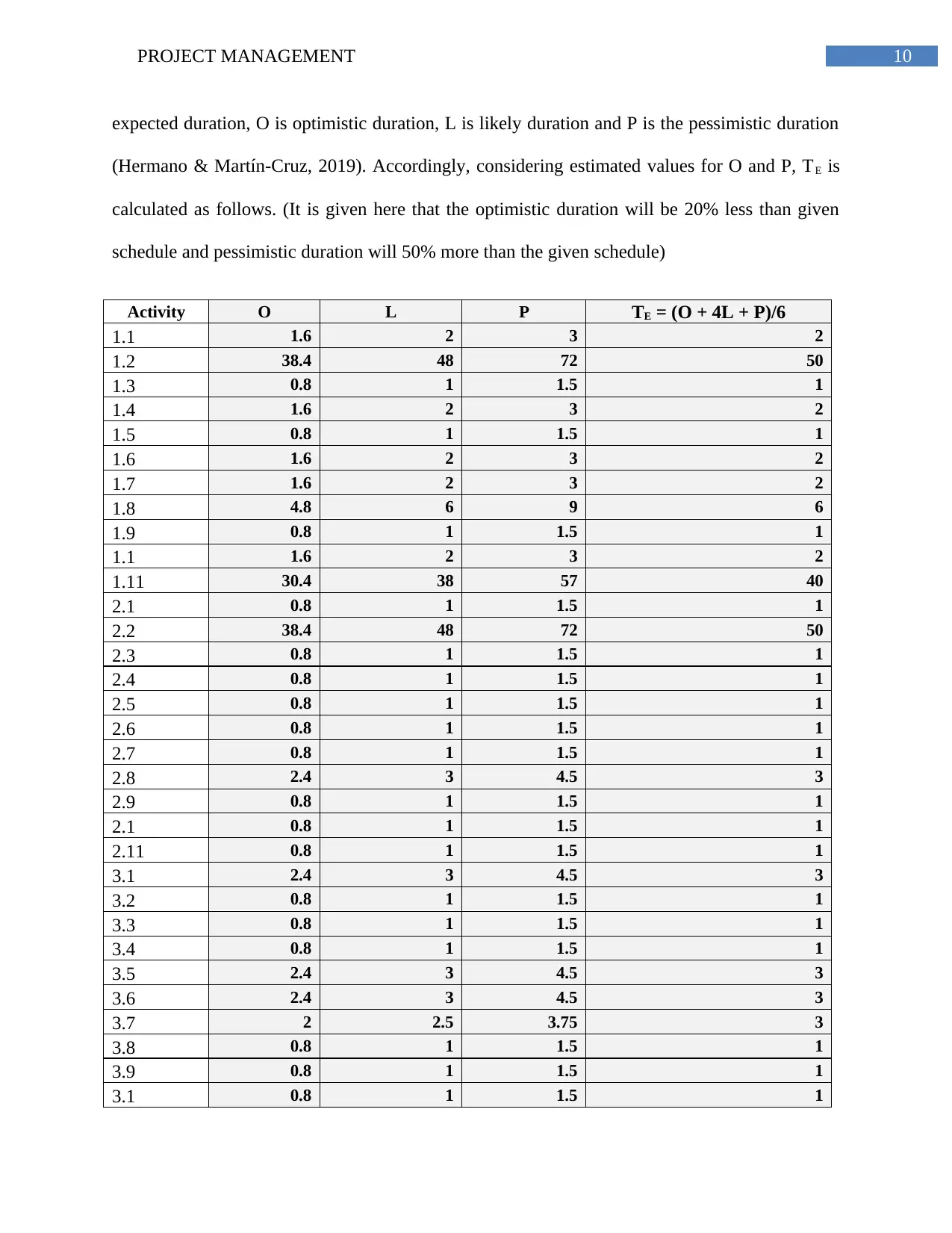
10PROJECT MANAGEMENT
expected duration, O is optimistic duration, L is likely duration and P is the pessimistic duration
(Hermano & Martín-Cruz, 2019). Accordingly, considering estimated values for O and P, TE is
calculated as follows. (It is given here that the optimistic duration will be 20% less than given
schedule and pessimistic duration will 50% more than the given schedule)
Activity O L P TE = (O + 4L + P)/6
1.1 1.6 2 3 2
1.2 38.4 48 72 50
1.3 0.8 1 1.5 1
1.4 1.6 2 3 2
1.5 0.8 1 1.5 1
1.6 1.6 2 3 2
1.7 1.6 2 3 2
1.8 4.8 6 9 6
1.9 0.8 1 1.5 1
1.1 1.6 2 3 2
1.11 30.4 38 57 40
2.1 0.8 1 1.5 1
2.2 38.4 48 72 50
2.3 0.8 1 1.5 1
2.4 0.8 1 1.5 1
2.5 0.8 1 1.5 1
2.6 0.8 1 1.5 1
2.7 0.8 1 1.5 1
2.8 2.4 3 4.5 3
2.9 0.8 1 1.5 1
2.1 0.8 1 1.5 1
2.11 0.8 1 1.5 1
3.1 2.4 3 4.5 3
3.2 0.8 1 1.5 1
3.3 0.8 1 1.5 1
3.4 0.8 1 1.5 1
3.5 2.4 3 4.5 3
3.6 2.4 3 4.5 3
3.7 2 2.5 3.75 3
3.8 0.8 1 1.5 1
3.9 0.8 1 1.5 1
3.1 0.8 1 1.5 1
expected duration, O is optimistic duration, L is likely duration and P is the pessimistic duration
(Hermano & Martín-Cruz, 2019). Accordingly, considering estimated values for O and P, TE is
calculated as follows. (It is given here that the optimistic duration will be 20% less than given
schedule and pessimistic duration will 50% more than the given schedule)
Activity O L P TE = (O + 4L + P)/6
1.1 1.6 2 3 2
1.2 38.4 48 72 50
1.3 0.8 1 1.5 1
1.4 1.6 2 3 2
1.5 0.8 1 1.5 1
1.6 1.6 2 3 2
1.7 1.6 2 3 2
1.8 4.8 6 9 6
1.9 0.8 1 1.5 1
1.1 1.6 2 3 2
1.11 30.4 38 57 40
2.1 0.8 1 1.5 1
2.2 38.4 48 72 50
2.3 0.8 1 1.5 1
2.4 0.8 1 1.5 1
2.5 0.8 1 1.5 1
2.6 0.8 1 1.5 1
2.7 0.8 1 1.5 1
2.8 2.4 3 4.5 3
2.9 0.8 1 1.5 1
2.1 0.8 1 1.5 1
2.11 0.8 1 1.5 1
3.1 2.4 3 4.5 3
3.2 0.8 1 1.5 1
3.3 0.8 1 1.5 1
3.4 0.8 1 1.5 1
3.5 2.4 3 4.5 3
3.6 2.4 3 4.5 3
3.7 2 2.5 3.75 3
3.8 0.8 1 1.5 1
3.9 0.8 1 1.5 1
3.1 0.8 1 1.5 1
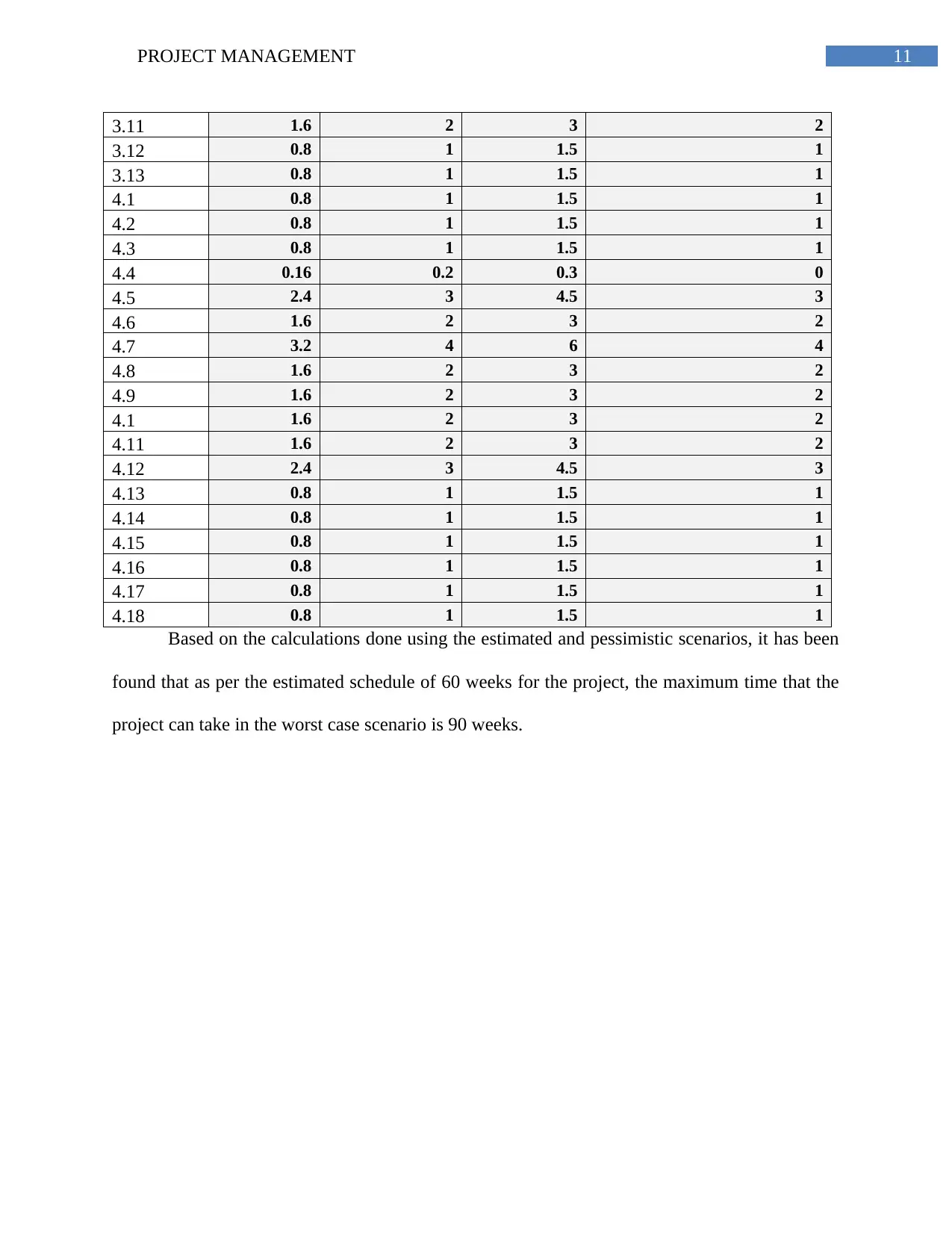
11PROJECT MANAGEMENT
3.11 1.6 2 3 2
3.12 0.8 1 1.5 1
3.13 0.8 1 1.5 1
4.1 0.8 1 1.5 1
4.2 0.8 1 1.5 1
4.3 0.8 1 1.5 1
4.4 0.16 0.2 0.3 0
4.5 2.4 3 4.5 3
4.6 1.6 2 3 2
4.7 3.2 4 6 4
4.8 1.6 2 3 2
4.9 1.6 2 3 2
4.1 1.6 2 3 2
4.11 1.6 2 3 2
4.12 2.4 3 4.5 3
4.13 0.8 1 1.5 1
4.14 0.8 1 1.5 1
4.15 0.8 1 1.5 1
4.16 0.8 1 1.5 1
4.17 0.8 1 1.5 1
4.18 0.8 1 1.5 1
Based on the calculations done using the estimated and pessimistic scenarios, it has been
found that as per the estimated schedule of 60 weeks for the project, the maximum time that the
project can take in the worst case scenario is 90 weeks.
3.11 1.6 2 3 2
3.12 0.8 1 1.5 1
3.13 0.8 1 1.5 1
4.1 0.8 1 1.5 1
4.2 0.8 1 1.5 1
4.3 0.8 1 1.5 1
4.4 0.16 0.2 0.3 0
4.5 2.4 3 4.5 3
4.6 1.6 2 3 2
4.7 3.2 4 6 4
4.8 1.6 2 3 2
4.9 1.6 2 3 2
4.1 1.6 2 3 2
4.11 1.6 2 3 2
4.12 2.4 3 4.5 3
4.13 0.8 1 1.5 1
4.14 0.8 1 1.5 1
4.15 0.8 1 1.5 1
4.16 0.8 1 1.5 1
4.17 0.8 1 1.5 1
4.18 0.8 1 1.5 1
Based on the calculations done using the estimated and pessimistic scenarios, it has been
found that as per the estimated schedule of 60 weeks for the project, the maximum time that the
project can take in the worst case scenario is 90 weeks.

12PROJECT MANAGEMENT
References
Hermano, V., & Martín-Cruz, N. (2019). Expanding the Knowledge on Project Management
Standards: A Look into the PMBOK® with Dynamic Lenses. In Project Management
and Engineering Research (pp. 19-34). Springer, Cham.
Kerzner, H., & Kerzner, H. R. (2017). Project management: a systems approach to planning,
scheduling, and controlling. John Wiley & Sons.
Reich, B. H., & Wee, S. Y. (2019, March). Searching for knowledge management practices in
the PMBOK Guide. In Proceedings of the PMI Research Conference.
Varajão, J., Colomo-Palacios, R., & Silva, H. (2017). ISO 21500: 2012 and PMBoK 5 processes
in information systems project management. Computer Standards & Interfaces, 50, 216-
222.
References
Hermano, V., & Martín-Cruz, N. (2019). Expanding the Knowledge on Project Management
Standards: A Look into the PMBOK® with Dynamic Lenses. In Project Management
and Engineering Research (pp. 19-34). Springer, Cham.
Kerzner, H., & Kerzner, H. R. (2017). Project management: a systems approach to planning,
scheduling, and controlling. John Wiley & Sons.
Reich, B. H., & Wee, S. Y. (2019, March). Searching for knowledge management practices in
the PMBOK Guide. In Proceedings of the PMI Research Conference.
Varajão, J., Colomo-Palacios, R., & Silva, H. (2017). ISO 21500: 2012 and PMBoK 5 processes
in information systems project management. Computer Standards & Interfaces, 50, 216-
222.
1 out of 13
Related Documents
Your All-in-One AI-Powered Toolkit for Academic Success.
+13062052269
info@desklib.com
Available 24*7 on WhatsApp / Email
![[object Object]](/_next/static/media/star-bottom.7253800d.svg)
Unlock your academic potential
© 2024 | Zucol Services PVT LTD | All rights reserved.





